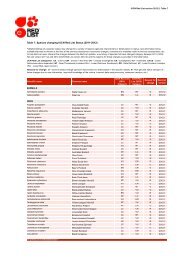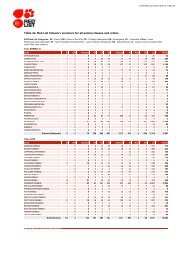IUCN Red List Guidelines - The IUCN Red List of Threatened Species
IUCN Red List Guidelines - The IUCN Red List of Threatened Species
IUCN Red List Guidelines - The IUCN Red List of Threatened Species
You also want an ePaper? Increase the reach of your titles
YUMPU automatically turns print PDFs into web optimized ePapers that Google loves.
<strong>Red</strong> <strong>List</strong> <strong>Guidelines</strong> 16<br />
at applying the criteria. In addition to the quality and completeness <strong>of</strong> the data (or lack <strong>of</strong>),<br />
there may be uncertainty in the data itself, which needs to be considered in a <strong>Red</strong> <strong>List</strong><br />
assessment. Data uncertainty is discussed separately in section 3.2.<br />
<strong>The</strong> <strong>IUCN</strong> criteria use the terms Observed, Estimated, Projected, Inferred, and Suspected to<br />
refer to the quality <strong>of</strong> the information for specific criteria. For example, criterion A allows<br />
inferred or suspected reduction, whereas criterion C1 allows only estimated declines and<br />
criterion C2 specifies “observed, projected, or inferred” declines. <strong>The</strong>se terms are defined as<br />
follows:<br />
Observed: information that is directly based on well-documented observations <strong>of</strong> all known<br />
individuals in the population.<br />
Estimated: information that is based on calculations that may include statistical assumptions<br />
about sampling, or biological assumptions about the relationship between an observed<br />
variable (e.g., an index <strong>of</strong> abundance) to the variable <strong>of</strong> interest (e.g., number <strong>of</strong> mature<br />
individuals). <strong>The</strong>se assumptions should be stated and justified in the documentation.<br />
Estimation may also involve interpolation in time to calculate the variable <strong>of</strong> interest for<br />
a particular time step (e.g., a 10-year reduction based on observations or estimations <strong>of</strong><br />
population size 5 and 15 years ago). For examples, see discussion under criterion A.<br />
Projected: same as “estimated”, but the variable <strong>of</strong> interest is extrapolated in time towards<br />
the future. Projected variables require a discussion <strong>of</strong> the method <strong>of</strong> extrapolation (e.g.,<br />
justification <strong>of</strong> the statistical assumptions or the population model used) as well as the<br />
extrapolation <strong>of</strong> current or potential threats into the future, including their rates <strong>of</strong><br />
change.<br />
Inferred: information that is based on indirect evidence, on variables that are indirectly<br />
related to the variable <strong>of</strong> interest, but in the same general type <strong>of</strong> units (e.g., number <strong>of</strong><br />
individuals or area or number <strong>of</strong> subpopulations). Examples include population<br />
reduction (A1d) inferred from a change in catch statistics, continuing decline in number<br />
<strong>of</strong> mature individuals (C2) inferred from trade estimates, or continuing decline in area <strong>of</strong><br />
occupancy (B1b(ii,iii), B2b(ii,iii)) inferred from rate <strong>of</strong> habitat loss. Inferred values rely<br />
on more assumptions than estimated values. For example, inferring reduction from<br />
catch statistics not only requires statistical assumptions (e.g., random sampling) and<br />
biological assumptions (about the relationship <strong>of</strong> the harvested section <strong>of</strong> the population<br />
to the total population), but also assumptions about trends in effort, efficiency, and<br />
spatial and temporal distribution <strong>of</strong> the harvest in relation to the population. Inference<br />
may also involve extrapolating an observed or estimated quantity from known<br />
subpopulations to calculate the same quantity for other subpopulations. Whether there<br />
are enough data to make such an inference will depend on how large the known<br />
subpopulations are as a proportion <strong>of</strong> the whole population, and the applicability <strong>of</strong> the<br />
threats and trends observed in the known subpopulations to the rest <strong>of</strong> the taxon. <strong>The</strong><br />
method <strong>of</strong> extrapolating to unknown subpopulations depends on the criteria and on the<br />
type <strong>of</strong> data available for the known subpopulations. Further guidelines are given under<br />
specific criteria (e.g., see section 5.8 for extrapolating population reduction for criterion<br />
A assessments).






